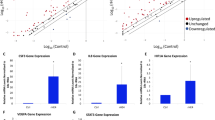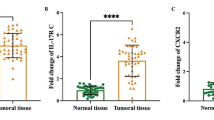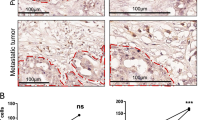Abstract
Objective
Transforming growth factor-1 (TGF-β1), vascular endothelial growth factor (VEGF), and interleukin-10 (IL-10) may be critical cytokines in the microenvironment of a tumor, playing roles in immune suppression. This study was conducted to elucidate the roles and immunosuppressive functions of these cytokines in epithelial ovarian cancer (EOC).
Methods
The expression levels of TGF-β1, VEGF and IL-10 in malignant tissue were evaluated by immune-histochemistry and compared with corresponding borderline, benign, and tumor-free tissues. Moreover, relationships among the levels of these cytokines and correlations between expression and the prognosis of EOC were analyzed by Pearson rank correlations and multi-factor Logistic regression. The roles of TGF-β1, VEGF, and IL-10 in the immunosuppressive microenvironment of ovarian cancer were studied through dendritic cell (DC) maturation and CD4+CD25+FoxP3+ Treg generation in vitro experiments.
Results
TGF-β1, VEGF, and IL-10 were expressed in 100%, 74.69%, and 54.96% of EOC patients, respectively. TGF-β1 was an independent prognostic factor for EOC. IL-10 was significantly co-expressed with VEGF. In vitro, VEGF and TGF-β1 strongly interfered with DC maturation and consequently led to immature DCs, which secreted high levels of IL-10 that accumulated around the tumor site. TGF-β1 and IL-10 induced Treg generation without antigen presentation in DCs.
Conclusions
TGF-β1, VEGF and IL-10 play important roles in EOC and can lead to frequent immune evasion events.
Similar content being viewed by others
References
Jemal A, Bray F, Center MM, et al. Global cancer statistics. CA Cancer J Clin 2011; 61:69–90.
Moses HL, Yang EY, Pietenpol JA. TGF-beta stimulation and inhibition of cell proliferation: new mechanistic insights. Cell 1990; 63:245–247.
Li MO, Wan YY, Sanjabi S, et al. Transforming growth factor-beta regulation of immune responses. Annu Rev Immunol 2006; 24:99–146.
Kriegel MA, Li MO, Sanjabi S, et al. Transforming growth factor-beta: recent advances on its role in immune tolerance. Curr Rheumatol Rep 2006; 8:138–144.
Shull MM, Ormsby I, Kier AB, et al. Targeted disruption of the mouse transforming growth factor-beta 1 gene results in multifocal inflammatory disease. Nature 1992; 359:693–699.
Blobe GC, Schiemann WP, Lodish HF. Role of transforming growth factor beta in human disease. N Engl J Med 2000; 342:1350–1358.
Gabrilovich DI, Chen HL, Girgis KR, et al. Production of vascular endothelial growth factor by human tumors inhibits the functional maturation of dendritic cells. Nat Med 1996; 2:1096–1103.
Furlan D, Sahnane N, Carnevali I, et al. Up-regulation of the hypoxia-inducible factor-1 transcriptional pathway in colorectal carcinomas. Hum Pathol 2008; 39:1483–1494.
Huang CL, Liu D, Ishikawa S, et al. Wnt1 overexpression promotes tumour progression in non-small cell lung cancer. Eur J Cancer 2008; 44:2680–2688.
Oh SY, Kwon HC, Kim SH, et al. Clinicopathologic significance of HIF-1alpha, p53, and VEGF expression and preoperative serum VEGF level in gastric cancer. BMC Cancer 2008; 8:123.
Kwon HC, Kim SH, Oh SY, et al. Clinicopathological significance of p53, hypoxia-inducible factor 1alpha, and vascular endothelial growth factor expression in colorectal cancer. Anticancer Res 2010; 30:4163–4168.
Abu-Jawdeh GM, Faix JD, Niloff J, et al. Strong expression of vascular permeability factor (vascular endothelial growth factor) and its receptors in ovarian borderline and malignant neoplasms. Lab Invest 1996; 74:1105–1115.
Shen GH, Ghazizadeh M, Kawanami O, et al. Prognostic significance of vascular endothelial growth factor expression in human ovarian carcinoma. Br J Cancer 2000; 83:196–203.
Duncan TJ, Al-Attar A, Rolland P, et al. Vascular endothelial growth factor expression in ovarian cancer: a model for targeted use of novel therapies? Clin Cancer Res 2008; 14:3030–3035.
Volk H, Asadullah K, Gallagher G, et al. IL-10 and its homologs: important immune mediators and emerging immunotherapeutic targets. Trends Immunol 2001; 22:414–417.
Wakkach A, Cottrez F, Groux H. Can interleukin-10 be used as a true immunoregulatory cytokine? Eur Cytokine Netw 2000; 11:153–160.
Nash MA, Lenzi R, Edwards CL, et al. Differential expression of cytokine transcripts in human epithelial ovarian carcinoma by solid tumour specimens, peritoneal exudate cells containing tumour, tumour-infiltrating lymphocyte (TIL)-derived T cell lines and established tumou cell lines. Clin Exp Immunol 1998; 112:172–180.
Rabinovich A, Medina L, Piura B, et al. Expression of IL-10 in human normal and cancerous ovarian tissues and cells. Eur Cytokine Netw 2010; 21:122–128.
Law AK, Lam KY, Lam FK, et al. Image analysis system for assessment of immunohistochemically stained proliferative marker (MIB-1) in oesophageal squamous cell carcinoma. Comput Methods Programs Biomed 2003; 70:37–45.
Wolf D, Wolf AM, Rumpold H, et al. The expression of the regulatory T cell-specific forkhead box transcription factor FoxP3 is associated with poor prognosis in ovarian cancer. Clin Cancer Res 2005; 11:8326–8331.
Zhang L, Conejo-Garcia JR, Katsaros D, et al. Intratumoral T cells, recurrence, and survival in epithelial ovarian cancer. N Engl J Med 2003; 348:203–213.
Gordinier ME, Zhang HZ, Patenia R, et al. Quantitative analysis of transforming growth factor beta 1 and 2 in ovarian carcinoma. Clin Cancer Res 1999; 5:2498–2505.
Shi HR, Song WJ, Chen ZM, et al. Expression and clinical significance of endostatin and vascular endothelial growth factor in ovarian carcinoma. Ai Zheng 2005; 24:1127–1131.
Diaz-Valdes N, Basagoiti M, Dotor J, et al. Induction of monocyte chemoattractant protein-1 and interleukin-10 by TGFbeta1 in melanoma enhances tumor infiltration and immunosuppression. Cancer Res 2011; 71:812–821.
Gholamin M, Moaven O, Memar B, et al. Overexpression and interactions of interleukin-10, transforming growth factor beta, and vascular endothelial growth factor in esophageal squamous cell carcinoma. World J Surg 2009; 33:1439–1445.
Troy A, Davidson P, Atkinson C, et al. Phenotypic characterisation of the dendritic cell infiltrate in prostate cancer. J Urol 1998; 160:214–219.
Troy AJ, Summers KL, Davidson PJ, et al. Minimal recruitment and activation of dendritic cells within renal cell carcinoma. Clin Cancer Res 1998; 4:585–593.
Pinzon-Charry A, Ho CS, Laherty R, et al. A population of HLA-DR+ immature cells accumulates in the blood dendritic cell compartment of patients with different types of cancer. Neoplasia 2005; 7:1112–1122.
Bergeron A, El-Hage F, Kambouchner M, et al. Characterisation of dendritic cell subsets in lung cancer micro-environments. Eur Respir J 2006; 28:1170–1177.
Baleeiro RB, Anselmo LB, Soares FA, et al. High frequency of immature dendritic cells and altered in situ production of interleukin-4 and tumor necrosis factor-alpha in lung cancer. Cancer Immunol Immunother 2008; 57:1335–1345.
Kryczek I, Liu R, Wang G, et al. FOXP3 defines regulatory T cells in human tumor and autoimmune disease. Cancer Res 2009; 69:3995–4000.
Zou W. Immunosuppressive networks in the tumor environment and their therapeutic relevance. Nat Rev Cancer 2005; 5:263–274.
Sakaguchi S, Sakaguchi N, Asano M, et al. Immunologic self-tolerance maintained by activated T cells expressing IL-2 receptor alpha-chains (CD25). Breakdown of a single mechanism of self-tolerance causes various autoimmune diseases. J Immunol 1995; 155:1151–1164.
Zhu X, Ma LL, Ye T. Expression of CD4(+)CD25(high)CD127(low/-) regulatory T cells in transitional cell carcinoma patients and its significance. J Clin Lab Anal 2009; 23:197–201.
Zhou J, Ding T, Pan W, et al. Increased intratumoral regulatory T cells are related to intratumoral macrophages and poor prognosis in hepatocellular carcinoma patients. Int J Cancer 2009; 125:1640–1648.
Li L, Chao QG, Ping LZ, et al. The prevalence of FOXP3+ regulatory T-cells in peripheral blood of patients with NSCLC. Cancer Biother Radiopharm 2009; 24:357–367.
Haas M, Dimmler A, Hohenberger W, et al. Stromal regulatory T-cells are associated with a favorable prognosis in gastric cancer of the cardia. BMC Gastroenterol 2009; 9:65.
Brinkrolf P, Landmeier S, Altvater B, et al. A high proportion of bone marrow T cells with regulatory phenotype (CD4+CD25hiFoxP3+) in Ewing sarcoma patients is associated with metastatic disease. Int J Cancer 2009; 125:879–886.
Hinz S, Pagerols-Raluy L, Ober HHG, et al. Foxp3 expression in pancreatic carcinoma cells as a novel mechanism of immune evasion in cancer. Cancer Res 2007; 67:8344–8350.
Li X, Ye DF, Xie X, et al. Proportion of CD4+CD25+ regulatory T cell is increased in the patients with ovarian carcinoma. Cancer Invest 2005; 23:399–403.
Li X, Ye F, Chen H, et al. Human ovarian carcinoma cells generate CD4(+)CD25(+) regulatory T cells from peripheral CD4(+)CD25(−) T cells through secreting TGF-beta. Cancer Lett 2007; 253:144–153.
Author information
Authors and Affiliations
Corresponding author
Additional information
This study was supported by the Natural Science Foundation of China (No. 30872750) and the Natural Science Foundation of Beijing (No. 7092108).
Rights and permissions
About this article
Cite this article
Liu, Cz., Zhang, L., Chang, Xh. et al. Overexpression and immunosuppressive functions of transforming growth factor 1, vascular endothelial growth factor and interleukin-10 in epithelial ovarian cancer. Chin. J. Cancer Res. 24, 130–137 (2012). https://doi.org/10.1007/s11670-012-0130-y
Published:
Issue Date:
DOI: https://doi.org/10.1007/s11670-012-0130-y




